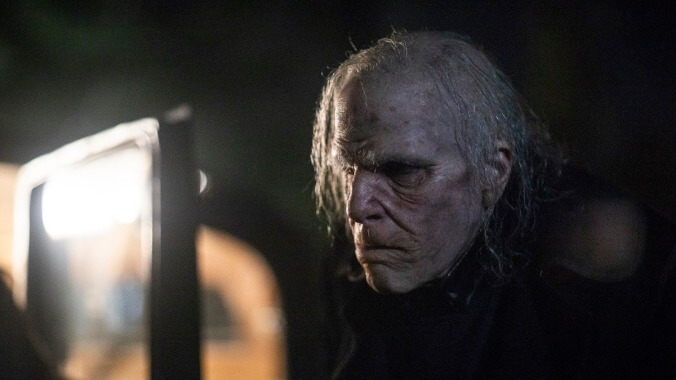AMC’s adaptation of Joe Hill’s NOS4A2 is NTG00D

Joe Hill’s surreal and dreamlike NOS4A2 needed a Tim Burton sensibility, but it gets a Joel Schumacher one in the drab and lifeless AMC adaptation. It’s a story that includes a killer car, magical covered bridge, and a mythical place called Christmasland, but no one behind this show could figure out the right tone, and so they largely go without one. The writers elongate the source material—the first season will only depict the early events of Hill’s 2013 novel—but don’t have enough new ideas to fill in the empty space they created by choosing to go so long with a single book. Instead of deepening the mythology, they spend way too much time on the least interesting elements. Worst of all, they give the whole thing a flat, TV-movie aesthetic that drains the source material of its power more quickly than its title character sucks the life from his victims.
Vic McQueen (Ashleigh Cummings) is not your typical teenager. Just as Hill’s father loved to explore young people with magical powers in his early fiction (think Carrie and The Shining), the eldest son of Stephen King presents us with a teenager who discovers that she’s not the same as her classmates and friends. In the series premiere, Vic flees her fighting parents and stumbles upon a wooden bridge in the woods that becomes nicknamed “The Shorter Way.” A supernaturally reconstructed version of a bridge that was blown up years ago, Vic discovers that she can ride this rickety construction to find missing things. It starts with a lost credit card and a missing watch—it escalates to something more intense.
At the same time, NOS4A2 introduces us to its villain, Charlie Manx (played under varying degrees of makeup by Zachary Quinto). Manx roams the dark of night in a haunted Rolls Royce Wraith, kidnapping ignored children with the promise of taking them off to somewhere called “Christmasland.” Again, Manx echoes one of King’s creations: Pennywise from It. Like that ancient evil, he uses imagery that usually brings joy—candy canes, wrapped presents, etc.—to lure his victims, whom he uses to stay young and alive. It’s a clever riff on the vampire mythology—Manx’s license plate gives the show its name and should be pronounced “Nosferatu”—in that the villain needs human lives to survive, in exchange promising them immortality and a happiness that the real world never provided. Manx claims that he is saving children from miserable lives, taking only kids from abusive homes, but that’s only loosely developed on the show.
The issue of abuse is backdrop to a lot of NOS4A2, and it feels cheap and manipulative. Vic’s mother (Virginia Kull) has bruises from Vic’s alcoholic father (Ebon Moss-Bachrach), and the two split up early in the season. The idea that Vic herself is a “lost child” could have been a thematically interesting tie to Charlie’s false savior narrative, but it’s so weakly developed that it just feels phony. Every time that NOS4A2 uses serious issues like abuse, PTSD, or class issues, it betrays how shallowly written the entire exercise has been and crosses that line from mediocre genre material to something that feels much more exploitative and gross.
The weak writing wouldn’t be such a problem if the show had an ounce of the visual flourish it so desperately needed to succeed. The visuals here are dull and drab in a way that’s simply baffling. Why would anyone make a show about a Wraith-driving vampire who goes to Christmasland and try to approach it so literally? Hill’s best work is trippy and strange and surreal—and none of those words could be used to describe this show. Consequently, Manx doesn’t come off as malevolent or supernatural as much as he just seems like an old creep. The total lack of tonal creativity amplifies what is perhaps the show’s biggest problem: a complete lack of dread. There’s nothing creepy or atmospheric about NOS4A2, a show that takes itself deadly seriously without earning it. A clever visual choice, a line that didn’t sound so weighted with meaning, an unexpected character twist—any of these things would help this deadly show come to life, and they so rarely happen that one is almost startled when the program does show a pulse.
This happens most often in the performance of Ashleigh Cummings, a charismatic young actress doing a lot of heavy lifting here to keep NOS4A2 even watchable. She’s asked to do a lot in the first arc of the season, and she seems up to the challenge, though it’s quickly apparent she’s a better actress than the material she’s been given. There’s also an interesting subplot, highlighted in episode four, in which Manx gets his Renfield, an affable oaf named Bing Partridge. Played by Ólafur Darri Ólafsson, Bing brings a different energy to the show. He is also a child of an abusive home, but his wide-eyed naïveté makes him dangerous and easily manipulated.
Joe Hill’s fiction allows for mental flights of fancy that can be tough to translate to the big or small screen. The very idea of mixing Christmas mythology with that of Bram Stoker conjures imagery in the reader’s mind of everything from shiny ornaments to bloody stakes. It could have resulted in a playful, crazy, over-the-top piece of escapism that emphasizes the surreal, dark whimsy of its source material. For reasons that will never make sense, no one involved with NOS4A2 seems like they were interested in making that show. The familial comparisons may be unfair, but here’s one more: AMC’s NOS4A2 needed the energy of the best cinematic Stephen King adaptations and it got the meat-and-potatoes treatment that his books did back in the heyday of the network TV miniseries.